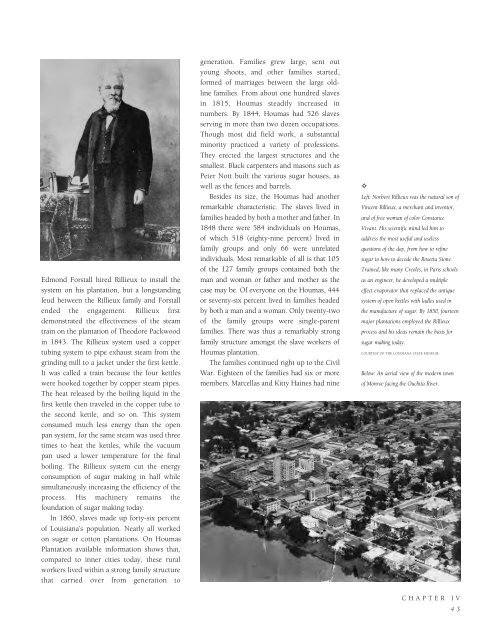Historic Louisiana
An illustrated history of Louisiana, paired with the histories of companies, families and organizations that make the state great.
An illustrated history of Louisiana, paired with the histories of companies, families and organizations that make the state great.
Create successful ePaper yourself
Turn your PDF publications into a flip-book with our unique Google optimized e-Paper software.
Edmond Forstall hired Rillieux to install the<br />
system on his plantation, but a longstanding<br />
feud between the Rillieux family and Forstall<br />
ended the engagement. Rillieux first<br />
demonstrated the effectiveness of the steam<br />
train on the plantation of Theodore Packwood<br />
in 1843. The Rillieux system used a copper<br />
tubing system to pipe exhaust steam from the<br />
grinding mill to a jacket under the first kettle.<br />
It was called a train because the four kettles<br />
were hooked together by copper steam pipes.<br />
The heat released by the boiling liquid in the<br />
first kettle then traveled in the copper tube to<br />
the second kettle, and so on. This system<br />
consumed much less energy than the open<br />
pan system, for the same steam was used three<br />
times to heat the kettles, while the vacuum<br />
pan used a lower temperature for the final<br />
boiling. The Rillieux system cut the energy<br />
consumption of sugar making in half while<br />
simultaneously increasing the efficiency of the<br />
process. His machinery remains the<br />
foundation of sugar making today.<br />
In 1860, slaves made up forty-six percent<br />
of <strong>Louisiana</strong>’s population. Nearly all worked<br />
on sugar or cotton plantations. On Houmas<br />
Plantation available information shows that,<br />
compared to inner cities today, these rural<br />
workers lived within a strong family structure<br />
that carried over from generation to<br />
generation. Families grew large, sent out<br />
young shoots, and other families started,<br />
formed of marriages between the large oldline<br />
families. From about one hundred slaves<br />
in 1815, Houmas steadily increased in<br />
numbers. By 1844, Houmas had 526 slaves<br />
serving in more than two dozen occupations.<br />
Though most did field work, a substantial<br />
minority practiced a variety of professions.<br />
They erected the largest structures and the<br />
smallest. Black carpenters and masons such as<br />
Peter Nott built the various sugar houses, as<br />
well as the fences and barrels.<br />
Besides its size, the Houmas had another<br />
remarkable characteristic. The slaves lived in<br />
families headed by both a mother and father. In<br />
1848 there were 584 individuals on Houmas,<br />
of which 518 (eighty-nine percent) lived in<br />
family groups and only 66 were unrelated<br />
individuals. Most remarkable of all is that 105<br />
of the 127 family groups contained both the<br />
man and woman or father and mother as the<br />
case may be. Of everyone on the Houmas, 444<br />
or seventy-six percent lived in families headed<br />
by both a man and a woman. Only twenty-two<br />
of the family groups were single-parent<br />
families. There was thus a remarkably strong<br />
family structure amongst the slave workers of<br />
Houmas plantation.<br />
The families continued right up to the Civil<br />
War. Eighteen of the families had six or more<br />
members. Marcellas and Kitty Haines had nine<br />
✧<br />
Left: Norbert Rillieux was the natural son of<br />
Vincent Rillieux, a merchant and inventor,<br />
and of free woman of color Constance<br />
Vivant. His scientific mind led him to<br />
address the most useful and useless<br />
questions of the day, from how to refine<br />
sugar to how to decode the Rosetta Stone.<br />
Trained, like many Creoles, in Paris schools<br />
as an engineer, he developed a multiple<br />
effect evaporator that replaced the antique<br />
system of open kettles with ladles used in<br />
the manufacture of sugar. By 1850, fourteen<br />
major plantations employed the Rillieux<br />
process and his ideas remain the basis for<br />
sugar making today.<br />
COURTESY OF THE LOUISIANA STATE MUSEUM.<br />
Below: An aerial view of the modern town<br />
of Monroe facing the Ouchita River.<br />
CHAPTER IV<br />
43
















